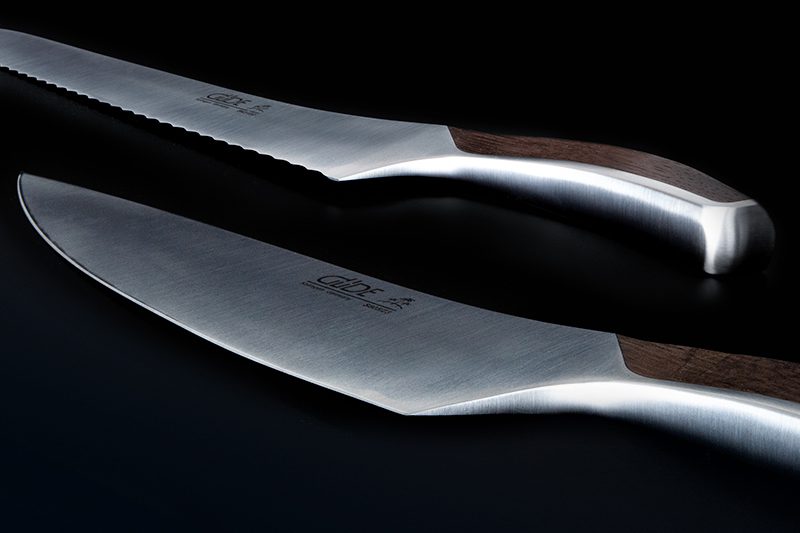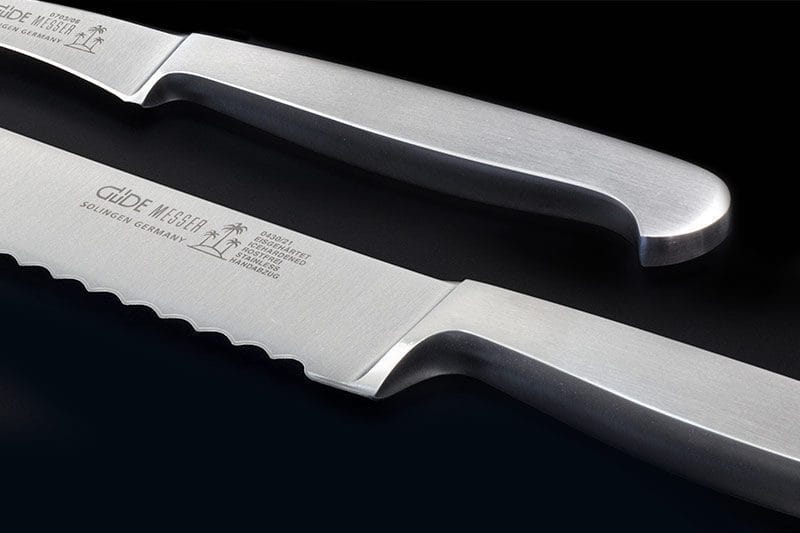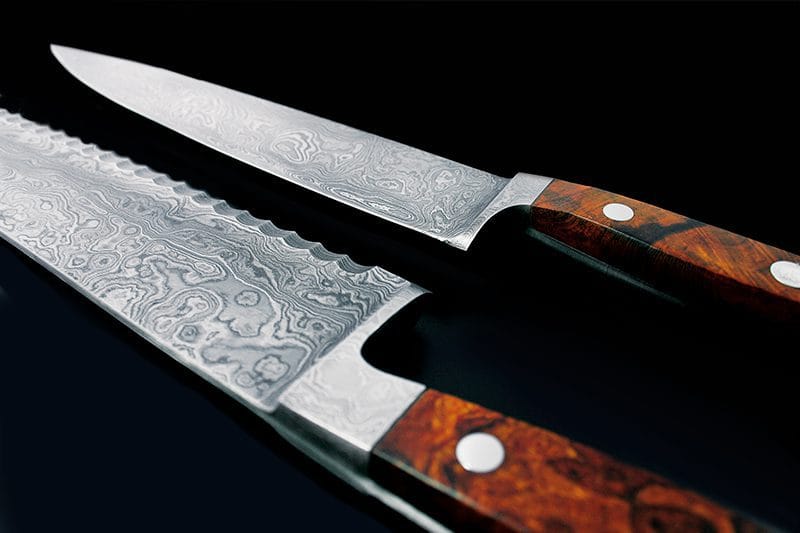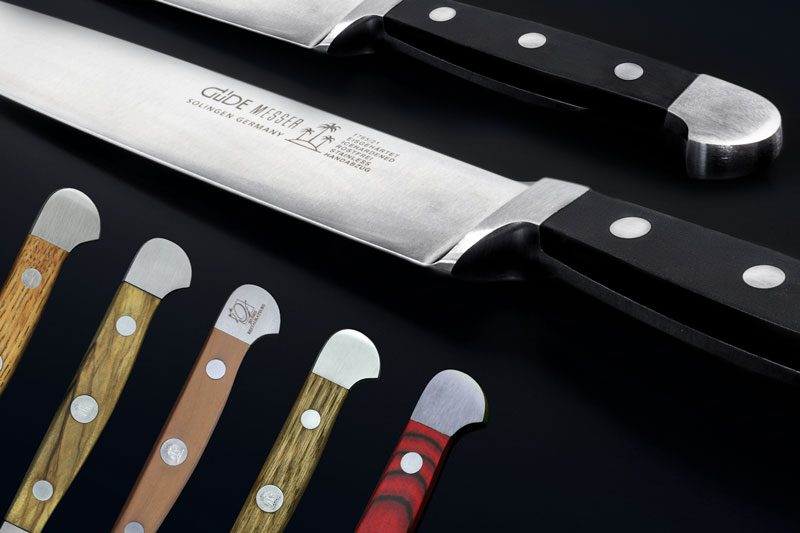Caminada
The Caminada knives are the result of a collaboration between the Swiss star chef Andreas Caminada. Consequently, the Caminada knives are perfectly aligned with the wishes and needs of this exceptional chef and correspond to his philosophy. At the age of 33, Andreas Caminada was already awarded three Michelin stars and 19 GaultMillau points.
A design language like that of the Caminada knives can only be realised in the traditional drop-forging process. The blade is ground through to the end, the half bolster as the transition from blade to handle, forged from one piece of steel using a centuries-old technology. More than 40 further manual operations are necessary to produce a unique piece of Solingen knifemaking art. The blade is stainless, ice-hardened and of course hand-sharpened. Due to the walnut handles, these knives should not be put in the dishwasher.

Material
The blade material of knives must sometimes fulfil contradictory requirements. It is therefore crucial to weigh up the different requirements and ensure an optimum. On the one hand, the knife steel should be hard, but not too hard, otherwise there is a risk that the blade will break under heavy use. On the other hand, however, the knife steel should not be too soft either, as ongoing wear and tear would cause the knife to lose its sharpness too quickly during use. That is why the knives in the Caminada series from GÜDE are made of a chrome-molybdenum-vanadium knife steel. This steel perfectly meets the sometimes contradictory requirements with an optimum hardness of approx. 57-58 HRc (Rockwell).
The hardness of the knife steel of the series Caminada of 57-58 HRc is not too hard and not too soft for the different requirements that a good knife must fulfil.
Such a degree of hardness makes the blade of knives from the Caminada series torsionally stiff, thus guaranteeing precise guidance of the knife and thus a precise cut. But even a hard steel, such as the GÜDE knife steel, can be ground very thin. In this way, even a hard steel can be very flexible.
Production
All knives in the Caminada series are traditionally drop-forged - from one piece of steel. The result of this traditional technology of drop forging is a particularly high material strength, even when the knife is subjected to dynamic stresses. During the forging process, the entire forging blank is heated in the die until it glows red and is then deformed between the two dies, the upper and lower die. In further detail-oriented manual work steps, the drop-forged blank is turned into an innovative one-of-a-kind knife from the knife manufactory GÜDE - handmade.
After forging in the die, the knives are stamped out of the forging blank and then roughly ground, calibrated and cleaned. This is followed by so-called ice-hardening: the knives are cooled to -80 °C to improve the structure of the microstructure in the blade steel. In the next step, the knives are tempered in two stages. Tempering is a term used by the knife makers in Solingen. Tempering means that the knife is heated again and thus made unbreakable. Now the blade is pre-ground. This is followed by the pre-grinding of the back of the knife, which is the upper part of the knife. This is followed by the fine grinding of the back of the knife and the grinding of the transition between the blade and the handle. The inner sides are now pre-ground for the attachment of the u-shaped handle shell. Pre-grinding the lower part of the handle takes another 5 steps. Only then can the blade be fine-ground. The Solingen knifemaker also calls this "pliesten". This gives the blade its unmistakable surface. The U-shaped walnut handle is now placed on the knife handle from above, glued and adjusted. Another five or so work steps are required to roughly sand the u-shaped handle shell on the tang below so that the transitions between wood and steel are smooth. These five steps must then be repeated with a finer sanding belt. Now the upper part of the knife, the back, gets its fine grinding. This is followed by the finest grinding of the half bolster, the thickening between the blade and the handle. Then the knife handles are pre-polished, followed by fine polishing. Only now does the knife get its sharpness trigger, because the knife edge, also called the bevel, is now sharpened (the knifemaker calls this "honing"). The edge is polished so that it glides better through the material to be cut. On the bread knives, the special GÜDE serrated edge is now applied. In the next step, the GÜDE logo is etched onto the blade. Cleaning and quality control are the final steps. After that, the knives are given a wooden sheath for protection. Last but not least, the shipping bags are provided with rivets and the labels belonging to the series and the blade type. The finished knives are now stored and ready for shipping.
Form
The technology of forging in the die creates degrees of freedom in the design language. From the end of the handle to the tip of the knife, shapes can be created that would not be possible with any other forging technology. For example, the design language with the half bolster between handle and blade and the continuous tang on the underside of the handle of the Caminada knives is only possible in the drop forging process. This explains impressively why GÜDE has remained true to this proven and traditional technology for four generations since its founding in 1910. The continuous tang at the bottom and the wrap-around end of the handle give the knives in the Caminada series their well-balanced appearance. For the user, this means: pleasant and fatigue-free work at the same time.
The term tang refers to the part of the steel to which the u-shaped handle of the knife in the Caminada series is attached from above. When the tang goes from the blade to the end of the handle, it is called a full tang. All knives in the Caminada series from GÜDE have a full tang. Because the full tang is on the underside of the handle, the inside of the hand does not come into contact with the cold steel but with the pleasant feel of the wood. The full tang, in combination with the half bolster, gives the knives a perfect balance of weight.
Visible over the entire length of the handle, both from above and below, the full tang proves that the knives in the Caminada series are forged from a single piece. No material transition, no seam - just as it must be with a knife that has been drop-forged from one piece.
Function
A good knife should not only be sharp, it should also stay sharp for as long as possible. A good knife should also lie well in the hand and be balanced so that fatigue-free and safe work is guaranteed at all times.
Sharpness and edge retention of the Caminada series are ensured both by the optimum hardness of the GÜDE blade steel with approx. 57-58 HRc (Rockwell) and by the GÜDE bevel angle of approx. 33 degrees. In addition, the blade of the knives in the Caminada series is ground right through to the beard, which makes it ideal for Asian cuisine.
Sharpness and edge retention are determined not only by the blade material but also by the bevel angle: cutting is like driving a wedge through a material to be cut. The more acute the angle of the wedge, i.e. the bevel angle, the easier it is to drive the wedge through the material to be cut. The term "bevel" is the knifemakers' term for the cutting edge, i.e. the sharply ground part of a knife. An acute bevel angle makes a knife sharper than a blunt bevel angle. If the bevel angle is too acute, however, the bevel can break. That is why the knives in the Caminada series from GÜDE have an optimum bevel angle of approx. 33 degrees. This angle guarantees both sharpness and stability. The chrome-molybdenum-vanadium blade steel of the Caminada series guarantees long-lasting sharpness with its hardness of approx. 57-58 HRc (Rockwell). It is important to always cut on a suitable cutting surface, e.g. wood or plastic. The balance of the knives in the Caminada series is a result of the full tang on the underside of the handle and the half bolster between the blade and the handle. This creates a counterweight to the blade in the area of the handle. For the user this means: Perfect balance and fatigue-free work with a secure grip at all times. The knives in the Caminada series deliver what the ambitious hobby chef expects from a perfect knife. Handcrafted, drop-forged from a single piece, with the experience of centuries of Solingen knifemaking.











